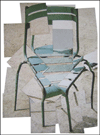Perspectives on science and art
- PMID: 17851068
- PMCID: PMC2813684
- DOI: 10.1016/j.conb.2007.07.010
Perspectives on science and art
Abstract
Artists try to understand how we see, sometimes explicitly exploring rules of perspective or color, visual illusions, or iconography, and conversely, scientists who study vision sometimes address the perceptual questions and discoveries raised by the works of art, as we do here.
Figures







Similar articles
-
Evolutionary neurobiology and art.Int Rev Neurobiol. 2006;74:1-14. doi: 10.1016/S0074-7742(06)74001-6. Int Rev Neurobiol. 2006. PMID: 16730502 No abstract available.
-
Art as science: scientific illustration, 1490-1670 in drawing, woodcut and copper plate.Endeavour. 2000;24(2):69-75. doi: 10.1016/s0160-9327(99)01262-4. Endeavour. 2000. PMID: 10969482
-
Artists as scientists: nature and realism in early modern Europe.Endeavour. 2000;24(1):13-21. doi: 10.1016/s0160-9327(99)01259-4. Endeavour. 2000. PMID: 10824439
-
[A brief history of syphilis. The disease through the art and the artist].Rev Med Liege. 2018 Jul;73(7-8):363-369. Rev Med Liege. 2018. PMID: 30113775 Review. French.
-
Art and the theatre of mind and body: how contemporary arts practice is re-framing the anatomo-clinical theatre.J Anat. 2010 Feb;216(2):251-63. doi: 10.1111/j.1469-7580.2009.01166.x. Epub 2009 Nov 19. J Anat. 2010. PMID: 19929908 Free PMC article. Review.
Cited by
-
Proprioceptive art: How should it be defined, and why has it become so popular?Iperception. 2022 Sep 6;13(5):20416695221120522. doi: 10.1177/20416695221120522. eCollection 2022 Sep-Oct. Iperception. 2022. PMID: 36092512 Free PMC article.
-
Art through the Colors of Graffiti: From the Perspective of the Chromatic Structure.Sensors (Basel). 2020 Apr 29;20(9):2531. doi: 10.3390/s20092531. Sensors (Basel). 2020. PMID: 32365638 Free PMC article.
-
Neuroaesthetics and the trouble with beauty.PLoS Biol. 2013;11(3):e1001504. doi: 10.1371/journal.pbio.1001504. Epub 2013 Mar 19. PLoS Biol. 2013. PMID: 23526878 Free PMC article.
-
Vision and art: an interdisciplinary approach to neuroscience education.J Undergrad Neurosci Educ. 2009 Fall;8(1):A10-7. Epub 2009 Oct 15. J Undergrad Neurosci Educ. 2009. PMID: 23493842 Free PMC article.
-
Universality and superiority in preference for chromatic composition of art paintings.Sci Rep. 2022 Mar 11;12(1):4294. doi: 10.1038/s41598-022-08365-z. Sci Rep. 2022. PMID: 35277597 Free PMC article.
References
-
- Hubel DH. In: Forward in Vision and Art, the Biology of Seeing. Livingstone M, editor. Abrams Press; 2002.
-
- Yarbus AL. Eye Movements and Vision. New York: Plenum Press; 1967.
-
- Reinagel P, Zador AM. Natural scene statistics at the centre of gaze. Network. 1999;10:341–350. - PubMed
-
- Leonards U, Baddeley R, Gilchrist ID, Troscianko T, Ledda P, Williamson B. Mediaeval artists: masters in directing the observers’ gaze. Curr Biol. 2007;17:R8–R9. - PubMed
-
-
Tyler CW. Painters centre one eye in portraits. Nature. 1998;392:877.. This study identifies the pervasive tendency of artists to center one eye along the horizontal axis of a portrait.
-
Publication types
MeSH terms
Grants and funding
LinkOut - more resources
Full Text Sources

